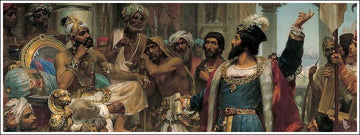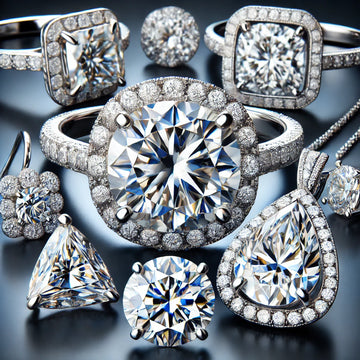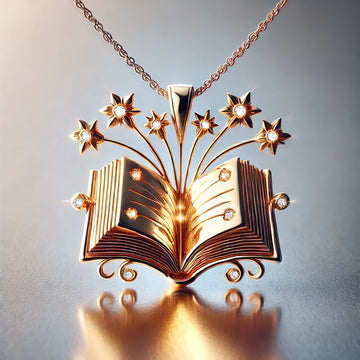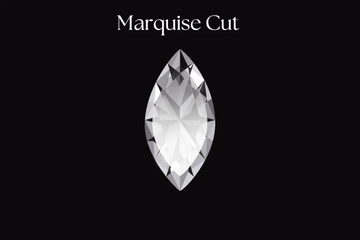
The history of diamonds spans millennia and takes us across cultures, continents, and centuries of human civilization. Here is an extensive exploration of the discovery, mining, and cultural significance of diamonds through the ages.
Origins and Early Discoveries (4th Century BCE - 1400s CE)
Diamonds were first discovered in ancient India as early as the 4th century BCE. India's rivers and streams, particularly in the Golconda region, were abundant sources. Early texts in Sanskrit refer to diamonds as "vajra," meaning "thunderbolt," a reference to the gem's striking appearance and alleged supernatural powers. Diamonds became symbols of strength, courage, and resilience, with tales suggesting they could protect wearers from evil and serve as a mark of divine favor.
Cultural Significance in India: Ancient Indian texts, like the "Ratnapariksha" by Buddhist scholar Buddhabhatta, classify diamonds by their color, shape, and flawlessness. Only the ruling class and nobility could possess the finest diamonds, and the belief was that they held powers, such as protection from poison and illness.
Diamonds Spread Westward (1400s - 1700s)
Introduction to Europe:** By the 1400s, diamonds had made their way to Europe via trade with India. The Venetians were key players in the gemstone trade, bringing diamonds through the ports of Venice. During the Renaissance, diamonds symbolized wealth, power, and social status. European monarchs and aristocrats coveted diamonds, and the gems quickly became associated with royalty and the aristocracy.
The Creation of Diamond Cutting Techniques:
Initially, diamonds were polished but left in their rough octahedral forms. However, advancements in cutting techniques began in the 15th century. Lodewyk van Berken, a Flemish diamond cutter, invented a diamond-polishing wheel called the "scaif," which enabled the creation of brilliant-cut diamonds. This process made diamonds even more desirable by enhancing their sparkle and was a major turning point in their cultural and commercial value.
The Indian Monopoly and the Discovery of Brazilian Mines (1700s)
For centuries, India held a monopoly on the world's diamonds. However, by the 18th century, Indian mines began to dwindle. Around 1725, large diamond deposits were discovered in Brazil, shifting the focus of diamond mining from India to the New World. The Portuguese colonial government in Brazil controlled these mines, which supplied diamonds to European markets for over a century.
Brazilian Influence on Diamond Fashion: Diamonds became even more accessible, especially among Europe's expanding middle class. The increasing supply allowed for the creation of more elaborate jewelry pieces, and diamonds became integral to Baroque and Rococo fashion trends. Brazilian diamonds also held symbolic value, as they were worn by European elites in the courts of France, England, and Russia.
The Discovery of Diamonds in South Africa (1860s - Early 1900s)
The Kimberley Mine and the Diamond Rush: The discovery of diamonds in Kimberley, South Africa, in the late 1860s was a turning point in diamond history. A young boy named Erasmus Jacobs found a transparent stone along the banks of the Orange River, which turned out to be a diamond. The news sparked the "Diamond Rush," attracting thousands of prospectors to Kimberley, and gave rise to massive diamond mining operations.
Formation of De Beers and the Birth of the Diamond Industry:
In 1888, British businessman Cecil Rhodes founded De Beers Consolidated Mines Limited, which quickly became the dominant force in the diamond industry. By controlling supply and establishing a centralized cartel, De Beers was able to stabilize diamond prices and effectively create the modern diamond market.
The Creation of Diamond Grading Standards: During this period, the understanding of diamonds as graded gemstones—based on clarity, color, cut, and carat—began to take shape. Although formal grading standards weren’t introduced until later, the idea of quality and rarity was increasingly recognized in marketing and trading practices.
The “A Diamond is Forever” Campaign and the Modern Diamond Market (1930s - Present)
The Marketing Revolution: In 1947, De Beers launched what would become one of the most iconic advertising campaigns in history, with the slogan “A Diamond is Forever.” The campaign played a critical role in positioning diamonds as symbols of love and commitment, especially in engagement rings. De Beers effectively linked diamonds to romance and created a cultural expectation that engagement rings should feature a diamond.
Post-War Demand and New Sources:
After World War II, demand for diamonds surged, and new deposits were discovered in Africa, including in Botswana, Angola, and Namibia. These new sources reduced reliance on South African diamonds and helped democratize diamond ownership by making them more affordable.
Diamond Grading System Established: The Gemological Institute of America (GIA) established the Four Cs—Cut, Color, Clarity, and Carat—in the 1950s. This system provided a universal standard for evaluating and pricing diamonds and made it easier for consumers to understand the value of a diamond.
Ethical Concerns and Synthetic Diamonds (1980s - Present)
The Conflict Diamond Crisis: In the late 20th century, the issue of "blood diamonds" or "conflict diamonds" emerged, drawing attention to the human cost of diamond mining in war-torn regions. These diamonds were often mined in Africa and used to fund armed conflicts. In response, the Kimberley Process Certification Scheme was introduced in 2003 to prevent conflict diamonds from entering the global market.
The Rise of Lab-Grown Diamonds:** Advances in technology have made it possible to create synthetic diamonds that are virtually indistinguishable from natural diamonds. Lab-grown diamonds are typically cheaper and are considered more ethical and environmentally friendly, as they avoid the social and environmental costs of traditional mining. They also appeal to younger consumers who are conscious of sustainability issues.
Today’s Diamond Market: Today, diamonds are valued both for their beauty and their symbolism. Major producers include Russia, Botswana, Canada, and Australia, alongside synthetic diamond companies. The market now caters to a wide range of consumers, offering both natural and synthetic diamonds to meet varying ethical preferences and budgets.
Conclusion
From ancient India's riverbeds to modern laboratory techniques, diamonds have traveled a long path. The gem's enduring allure is as much a story of cultural significance and human ingenuity as it is of natural beauty. From an emblem of divine favor and royalty, diamonds have transformed into a global symbol of love, wealth, and beauty, cementing their place in human history.

 Engagement Ring
Engagement Ring  Anniversary Rings
Anniversary Rings Solitaire Rings
Solitaire Rings Halo Rings
Halo Rings Men's Ring
Men's Ring Toi Moi Ring
Toi Moi Ring Three Stone Rings
Three Stone Rings Nature Inspired Rings
Nature Inspired Rings Rose Cut Diamond Rings
Rose Cut Diamond Rings Fancy Color Rings
Fancy Color Rings Antique Cut Diamond Rings
Antique Cut Diamond Rings Wedding rings
Wedding rings All Lab Grown Diamond Ring
All Lab Grown Diamond Ring Engagement Ring
Engagement Ring  Three Stone Rings
Three Stone Rings Daily Wear
Daily Wear Fancy Color Rings
Fancy Color Rings Antique Cut Diamond Rings
Antique Cut Diamond Rings Earrings
Earrings Bracelet
Bracelet Pendent
Pendent Necklace
Necklace Men's Ring
Men's Ring Bridal Sets
Bridal Sets Rings
Rings Earrings
Earrings Tennis chain
Tennis chain Custom Pendent
Custom Pendent Custom Ring
Custom Ring Custom Teeth Grillz
Custom Teeth Grillz Round
Round Oval
Oval Cushion
Cushion Marquise
Marquise Pear
Pear Emerald
Emerald Heart
Heart Princess
Princess Rose Cut
Rose Cut Radiant
Radiant Antique Cut
Antique Cut


